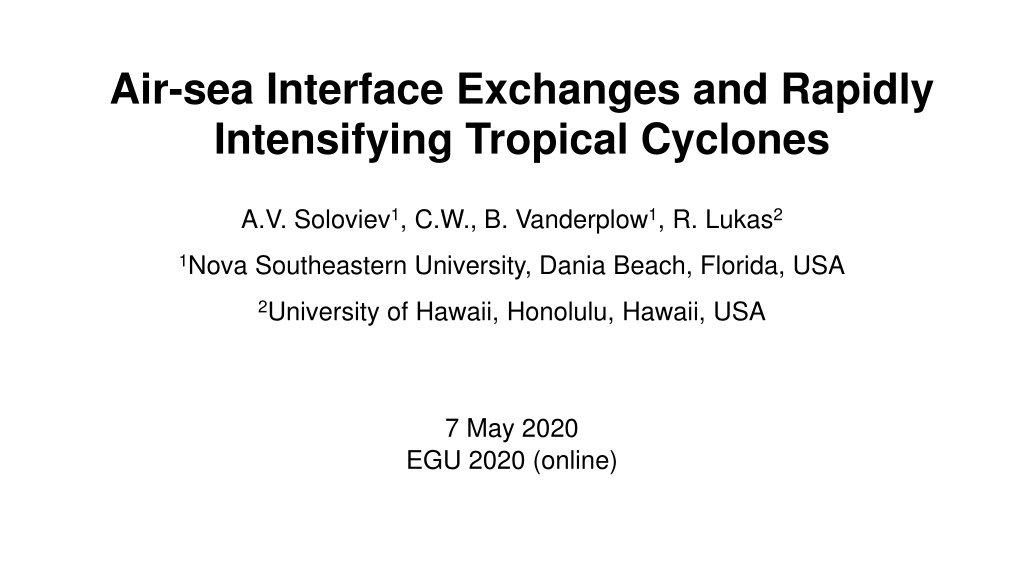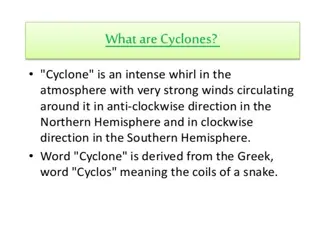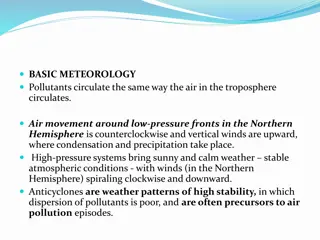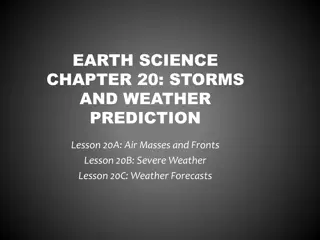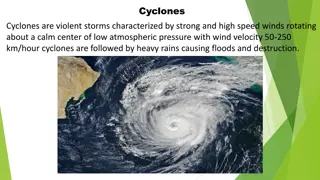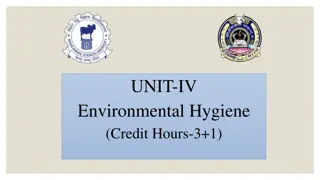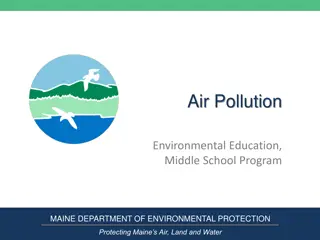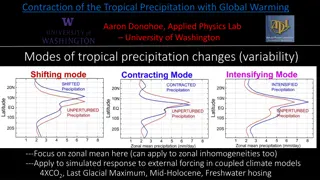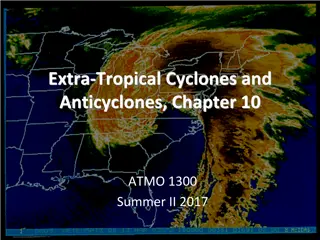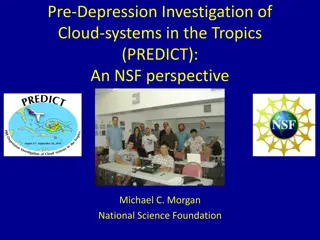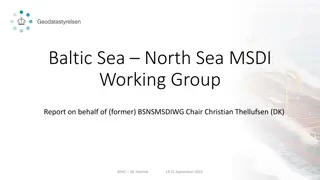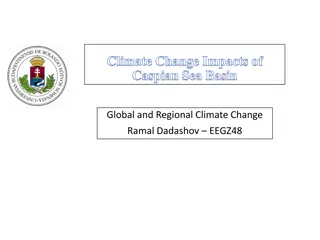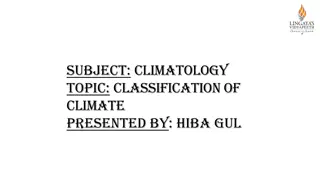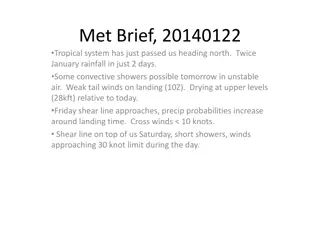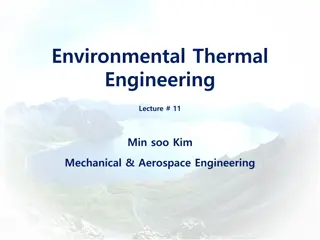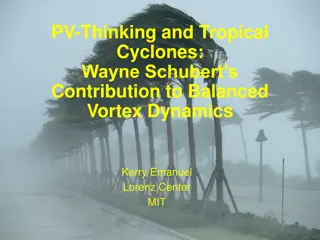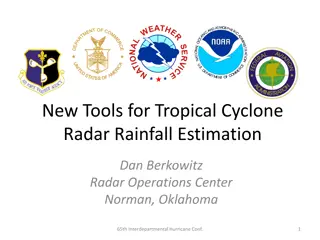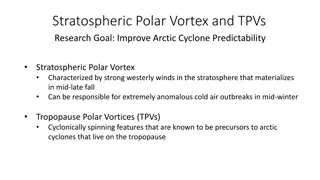Air-Sea Interface Dynamics in Tropical Cyclones
Examining the influence of microphysics at the air-sea interface on the rapid intensification of tropical cyclones. Explore the impact of sea spray and theoretical models on cyclone dynamics, energy generation rates, and maximum intensity predictions.
Download Presentation

Please find below an Image/Link to download the presentation.
The content on the website is provided AS IS for your information and personal use only. It may not be sold, licensed, or shared on other websites without obtaining consent from the author.If you encounter any issues during the download, it is possible that the publisher has removed the file from their server.
You are allowed to download the files provided on this website for personal or commercial use, subject to the condition that they are used lawfully. All files are the property of their respective owners.
The content on the website is provided AS IS for your information and personal use only. It may not be sold, licensed, or shared on other websites without obtaining consent from the author.
E N D
Presentation Transcript
Air-sea Interface Exchanges and Rapidly Intensifying Tropical Cyclones A.V. Soloviev1, C.W., B. Vanderplow1, R. Lukas2 1Nova Southeastern University, Dania Beach, Florida, USA 2University of Hawaii, Honolulu, Hawaii, USA 7 May 2020 EGU 2020 (online)
Motivation Rapid intensification is a serious challenge for the tropical cyclone intensity prediction The role of microphysics at the air-sea interface has been underestimated in the problem of rapid intensification The influence of sea spray is a significant uncertainty To study the effect of spray on dynamics of tropical cyclones, we have implemented theoretical considerations by Emanuel (1995); Shay (2001); Lin et al. (2013), Andreas et al. (2015), Lee et al. (2019), Peng and Richter (2019) and a Volume of Fluid to Discrete-Phase Method (VOF to DPM)
Maximum Tropical Cyclone Intensity depends on the Potential Intensity (PI) index (Emanuel 1995; Shay 2001; Lin et al. 2013), T T C C ( ) = 2 * 0 k V k k _ OC PI T 0 D Net energy gain rate (NGR), introduced by Lee et al. (2019) as the energy generation rate (G) minus the surface frictional dissipation rate (D), represents the potential for rapid intensification: T T NGR G D C T ( ) = = * 3 0 V k k C V k S D S : 0
Sea Surface during Hurricane Hugo Over 100 knot wind and 60-80 feet height waves NOAA Photo Library The white cap coverage increases with wind but at very high wind speeds remains at a constant 4% level, while the white out coverage increases toward full saturation (Holthuijsen et al. 2012).
Air-Sea Interface Under Tropical Cyclones The streaks on photos cannot be always traced to white caps (breaking waves) and are the results of a different process Analogy to the process of atomization in engineering applications such as fuel injection in combustion and rocket engines, food processing, inkjet printing (Ling et al., 2015; Shinjo & Umemura, 2010) The instability occurs in different forms including the well-known interfacial mode (Helmholtz, 1868; Thomson [Kelvin], 1871) and the liquid mode (Yecko et al., 2002; Holmboe, 1962) In engineering applications, the combination of all these modes is called the Kelvin-Helmholtz instability (somewhat extending the initial definition given by Kelvin and Helmholtz)
VOF to DPM: Mesh Adaption and Conversion to Lagrangian Particles
Formation of spray droplets under strong wind (U10=40 ms-1) is consistent with the Kelvin-Helmholtz instability at the interface with very large density difference VOF to DPM simulation Laboratory experiment (After Soloviev, A. V., Lukas, R., Donelan, M.A., Haus, B. K., Ginis, I. (2017). Is the state of the air-sea interface a factor in rapid intensification and rapid decline of tropical cyclones? JGR-Oceans 122, 10174-10183.)
Spray Size Distributions for Category 1 Tropical Cyclone Conditions in the VOF-to-DPM Model
Spray size distributions for Category 1, 3, and 5 Tropical Cyclone Conditions Using the VOF-to-DPM Model Spume particles are important for the enthalpy supply to tropical cyclones (Andreas et al. 2015, Peng and Richter 2019) Scales simulation below 0.1 mm diameter is affected by the spatial resolution of the model
Conclusions Microphysics of the air-sea interface is a key to understanding rapid intensification of tropical cyclones. The volume of fluid to discrete phase method (VOF to DPM) significantly reduces computational costs and can model sub-millimeter size spray particles. VOF to DPM next steps: verify with lab experiment at SUSTAIN, include heat exchange, spray evaporation, and surfactants.
Acknowledgements We thank Cayla Dean (NSU) for the VOF-DPM model development and Brian Haus (UM) for discussion of the results. This work has been supported by: NOPP project Advanced coupled atmosphere-wave-ocean modeling for improving tropical cyclone prediction models (PIs: Isaac Ginis, URI and Shuyi Chen, UM) Gulf of Mexico Research Initiative (GoMRI) Consortium for Advanced Research on the Transport of Hydrocarbons in the Environment Grant Award Number SA 18-14 (PI: Tamay zg kmen, UM) ONR Grant Award Number N00014-18-1-2835 (PI: Alex Soloviev)
